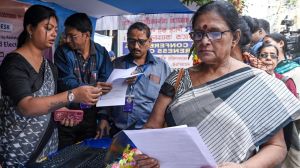Carving a niche
Siddhagiri Museum,a sprawling open-air museum of statues,which has often been compared by NRI bloggers to Madame Tussauds of London.
The Siddhagiri Museum near Kolhapur has over 700 statues in brick and cement and has drawn comparisons to Madame Tussauds. But the two couldnt be more dissimilar
Till about two years ago,tourist buses and vans would cruise down the Mumbai-Bangalore highway,taking pilgrims to the 1,200-year-old Shiva temple in Siddhagiri Math and take them back the same highway. But now,they stop by for a day to visit the Siddhagiri Museum,a sprawling open-air museum of statues,which has often been compared by NRI bloggers to Madame Tussauds of London.
But if the wax figures at Madame Tussauds are all about glamour and power,the brick and cement statues at the Siddhagiri Math celebrate the countrys rich heritage and the Gandhian dream of a self-sustained rural India.
In February 2007,the head of the Siddhagiri Math,Adrushya Kadsiddheshwar Swamy,decided to develop a museum that captured the spirit of rural India. The Math got over 100 sculptors from Karnataka to work on the statues and,with help from villagers,set up the Siddhagiri Museum.
We all keep talking about Indias past and our culture,but not many know much about it. Our educational system is skewed too. Our history books teach us what the British thought of our past, says Adrushya Kadsiddheshwar Swami.
The museum,spread over eight acres,houses over 700 statues. One section of the museum is a cave that has statues of some of the greatest thinkers the country has produced. With some dramatic props and backgrounds,the museum has sculptures of yoga guru Patanjali; sage Kanada who founded the philosophical school of Vaisheshika; Charaka,considered the father of Ayurveda; Chanakya the economist-politician,Nagarjuna the metallurgist,Bhaskaracharya the mathematician and many more.
The Math stridently believes that the thinkers of those times werent given the credit they deserved. Not many know that Maharshi Kashyap was the first paediatrician of the world. The first stethoscope was invented by Indians. Indians were far more superior to the rest of the world in surgery,engineering and many more, says Tejas Thakur,one of the coordinators of the Math.
The second section of the museum talks about an ideal,self-sustained village. There are sculptures of everyday life in villages and of pot makers,carpenters,goldsmiths,cobblers,butchers and others. The Balutedar community of Maharashtra lived in self-sufficient villages. Every village was an independent unit with schools,shops and even arrangements for social and cultural engagements, says Swamiji.
Whats interesting is the detailing. For instance,a sculpture of a village sarpanch has photo frames,old lamp shades,brick design of the walls and earthen pots in the kitchen. The sculptor has also breathed life into his work as the sarpanch is depicted addressing villagers. There are even sculptures of some extinct village games,places of gathering,an ideal market place and so on. The ideal village is an attempt to tell villagers that they shouldnt be waiting for the government to do things for them. So we encourage them to come here and see what they can do to their villages, says Swamiji.
Also handled and depicted effectively as a separate entity is the practice of farming. The life-size statues in open fields not only explain the enriched life of a farmer,but also set an example for those who are moving towards urbanisation neglecting the potential that exists in farming and villages in general.
The Siddhagiri Mathand now the museumis a popular tourist destination,with over 1,000 people visiting the temple every day during the summer break. Other than the fact that the museum has generated employment for us all,it has also brought about positive changes in all the villages around. All the villages here are Nirmal Grams. We practise cooperative farming too, says Arvind Mane,a villager.
- 01
- 02
- 03
- 04
- 05






























